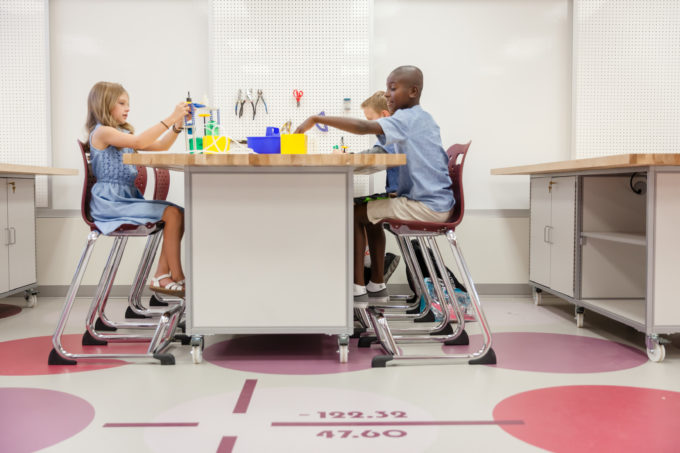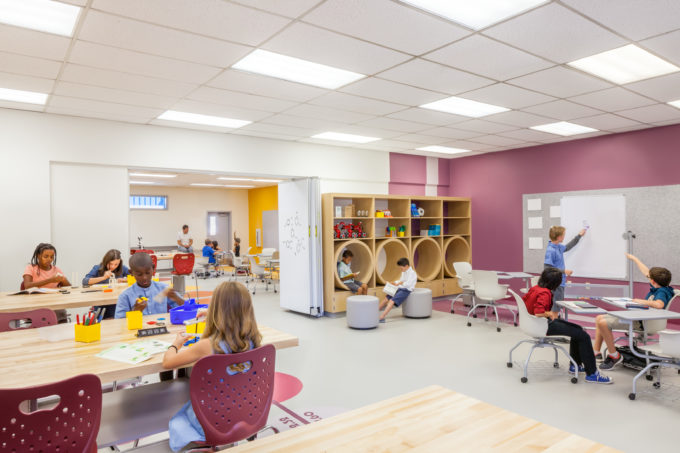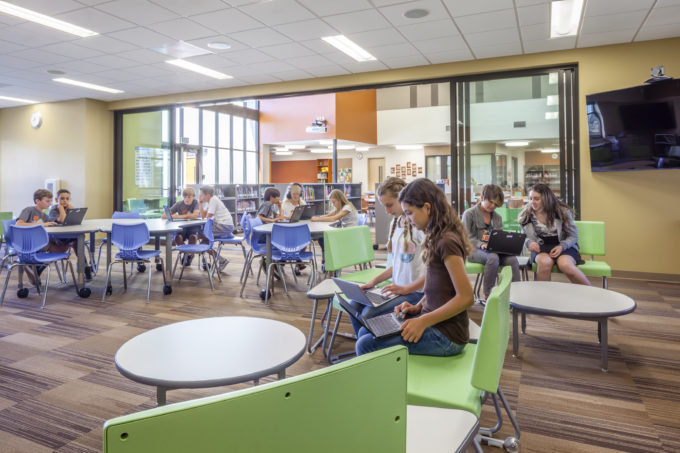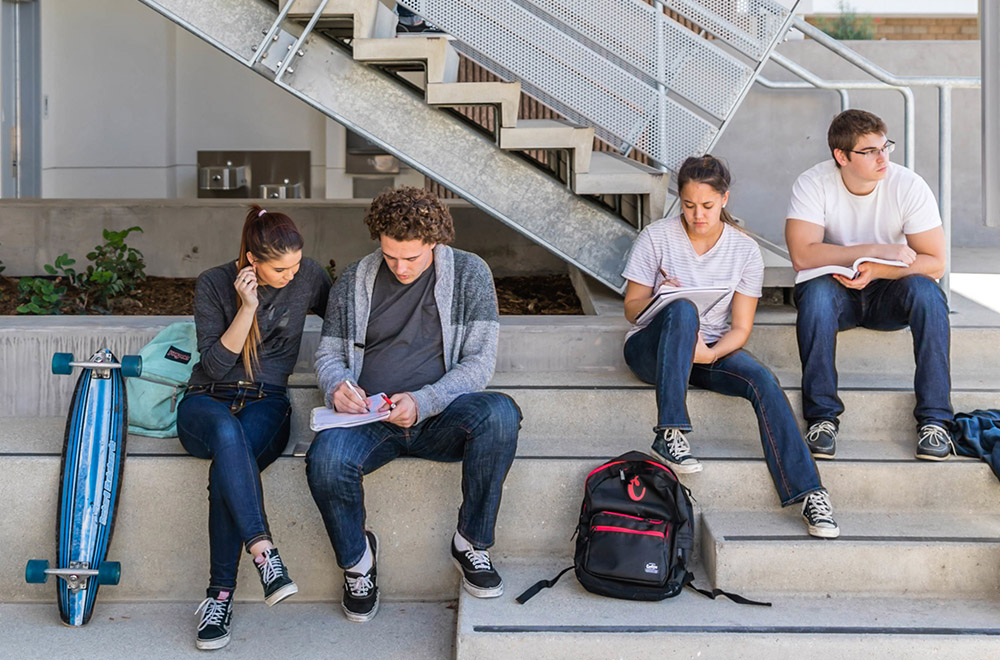Today’s students thrive in classroom environments that facilitate student engagement, collaboration, and connections with teachers. Studies show when schools incorporate flexible classroom furniture together with paralleled technology, student learning often improves dramatically—because students are offered classroom spaces that have the ability to flex in alignment with their different learning styles.

However, many schools today still aren’t equipped to support increased student engagement. In many classrooms, students sit at traditional desks every day while the teacher lectures from the front of the room. This type of classroom design doesn’t account for individualized student learning, and peer-to-peer collaboration, and seamless integration of technology.
Instead, consider incorporating reconfigurable classroom furniture, adaptable technology, and flexible layouts in your school. With careful planning and expert guidance from a designer, you can easily make these changes in your classrooms without significant renovations. A change in classroom furniture might seem like a minor design detail, but it has the power to completely transform your school environment for the better.
How Innovative Classroom Furniture Fosters Collaboration
As teachers experience daily, the primary problem with traditional desks or stationary tables and chairs is they limit student movement around the classroom. If a teacher wants to gather students in a circle to have a discussion, or the students want to collaborate with one another on a project, students need to push their heavy desks across the room, which is both time-consuming and messy.
You can encourage student participation and create more hands-on learning experiences using classroom furniture that is easily reconfigurable. School experiences should be about discovery, and innovative classroom furniture can promote this type of learning.
Innovative classroom furniture allows students and teachers to vary their routines. This has many benefits, including:
- Encouraging peer-to-peer collaboration: With easily movable desks, students can sit next to a new person every day, which encourages collaboration and creates a more supportive classroom environment. Students will get to know their peers a little better.
- Breaking down the classroom hierarchy: Innovative classroom furniture, such as modular mobile desks and chairs, make it easy to gather everyone in a circle to have open class discussions where all participants have equal footing.
- Offering multiple options: Every student learns differently. Some want to work independently so they can focus on the task in front of them. Others need the support of their fellow students. Offering a variety of chair and desk configurations that cater to multiple learning styles will make every student feel more comfortable and supported.
Innovative classroom furniture provides flexibility and variety, helping to minimize learning challenges. With only a few minor renovations, you can provide every student with an ideal learning environment.
Finding Customized Classroom Furniture Solutions
To incorporate innovative classroom furniture into your school, you first need to consider what type of furniture will best support your pedagogy. You have a range of options, from mobile desks and flexible chairs to modern study carrels. The type of furniture you choose depends on your classroom instruction approach. For example, do you want to assign more group projects or foster individual learning experiences—or both?
When administrators at Washington Elementary School in Sacramento, California created a new STEAM (Science, Technology, Engineering, Art, and Math) program, they centered their curriculum on group participation. To meet this educational approach, they incorporated a variety of innovative classroom furniture, including:
- Mobile pegboards to store supplies, making it easier for students to find what they need for hands-on projects.
- Circular open-seating nooks built into the wall to give students a place to study without isolating them completely from the rest of the group.
- Chairs and tables on wheels that make breaking into small groups faster and easier.
- Interactive outdoor play and work stations, allowing students to move their tables and chairs outside to engage in a different environmental experience.
If your school is more focused on individual learning, you’ll find a number of classroom furnishings that cater specifically to this need, too. For example, Double Peak School in San Marcos, California encourages students to develop their skills in fields like music, design, engineering, and coding. Administrators at San Marcos have a “one school” philosophy, meaning that they want every room in the building to feel open and connected, with plenty of multipurpose student workspaces.
This school used the following innovative design elements to improve individual student learning:
- Multi-purpose flex-labs and “maker spaces” that include all the tools students need to learn about technology and pursue their own inventions.
- Multiple data ports that allow students to plug their phones, tablets, and laptops into the wall from nearly any position in the room. Some desks and tables also include charging stations that students can use without leaving their seats.
- Wheeled tables that students and teachers can reconfigure, depending on whether they want to work alone or in groups.
- Sliding glass walls between rooms to make the space feel more open when an intimate learning environment isn’t required.
Although these schools have different educational environments, they have something in common: They use flexible, multi-purpose classroom furnishings to allow for a more interactive teaching approach. Administrators in these districts understand there’s no such thing as one-size-fits-all in education. Students thrive when learning environments are customizable.
How to Incorporate Innovative Classroom Furniture in Your School
Bringing new, flexible furnishings into your classrooms isn’t nearly as difficult as you might imagine. In many cases, it can be done without major renovations. In fact, one of our clients converted a small, unused space into a student-run radio station simply by focusing on minor changes to lighting and adding appropriately scaled furniture and multi-purpose work surfaces to offer the most functional plan in a tight space.
School administrators can make simple changes that go a long way toward encouraging class participation and supporting classroom efficiency. Introducing convertible desks with attached chairs that have folding tablet arms or hooks for hanging backpacks and jackets. Adding modular study carrels that offer students the option to work individually on a project. These flexible use stations will provide an option for quiet study in a crowded library or classroom. On the other hand, serpentine benching in libraries and classroom lounges can encourage collaboration. This kind of adaptable seating supports student learning anytime, anywhere.
A designer can help you integrate innovative furniture solutions that work seamlessly in classrooms of any size. By taking the time to understand your pedagogy, we can help you create environments that cater to a variety of learning styles. These environments will promote an enriching culture of learning—making your students better prepared to thrive in today’s ever-changing world.
HMC Architects has been working with Pre-K–12 schools and districts since 1940. We’re passionate, empowered, and we understand how students learn. As education continues to evolve, so will we.



